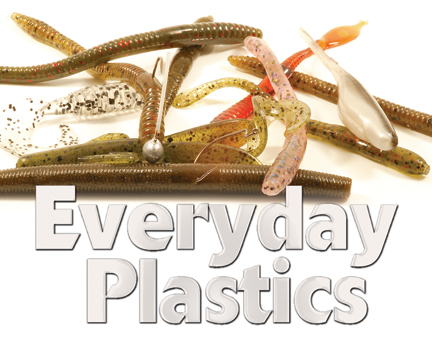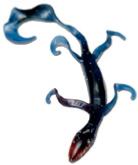Everyday plastics
Soft plastics play a major role in many fishing situations

Several years ago, while competing in a tournament on Lake Lanier, I drew a local angler whose tackle boxes were filled to the brim with plastic worms that contained his “tried and true” colors. He also lugged a large canvas bag stuffed with packets of worms in odd colors and sizes, “just in case you’re catching bass on a worm I don’t normally throw,” he said.
You cannot blame this paranoid angler for his obsession. Given the myriad styles, sizes and colors of soft-plastic baits available these days, it is hard to determine which ones you truly need – and, of course, you do need them. No matter what the season or where you fish, soft-plastic baits can spell the difference between victory and driving home with empty pockets.
Color selection
How do you narrow down plastic baits to a manageable number? Begin by limiting the colors. You would be wise to imitate Fujifilm pro Sam Swett of Covington, La., who relies mainly on four colors to handle various water conditions.
“My No. 1 go-to color is green pumpkin because it works in clear and stained water,” Swett said. “I prefer watermelon in clear water on sunny days. June bug and black neon are good colors for muddy water.”
Swett and other pros typically change their basic color selections with different types of baits. For example, an assortment of craws must have black and blue; pearl is vital with soft jerkbaits; and bubblegum simply has to be a part of everybody’s floating-worm arsenal.
Basic styles
The evolution of soft-plastic fishing lures officially began when Nick Creme Sr. invented the first plastic worm, the Scoundrel, in 1949. Over the ensuing half century, lure makers have morphed soft-plastic baits into new shapes and colors. Some changes have been major leaps, such as the hollow tube, which is indispensable.
Though the volume of different plastic baits made today is mind-boggling, these lures can be filed under the six categories below. If you fill each category with the basics, you will be prepared to cope with any fishing condition you may face.
Worms
4-inch Worm: Match a 4-inch straight worm with light line to combat crystalline water. Rig it Texas-style with a bullet sinker for casting presentations and the vertical doodling technique. It also works wonders with split-shotting, drop-shotting and a light jig head.
6-inch Worm: A straight 6-inch worm appeals to bass in clear and muddy water, and it works well in cover and over clean bottoms. Rig it Texas-style with a bullet sinker just heavy enough to maintain consistent bottom contact. Fish it shallow in the spring and deep in the summer.
7-inch Worm: Cast a 7-inch ribbontail worm to the same places you would a straight 6-inch worm. Many anglers prefer ribbontails when fishing submerged grass and other cover.
6-inch Ribbed Worm: Bulky, ribbed worms generally encourage more strikes when you flip or pitch them into dense cover. Texas-rig them and peg the sinker. This bait often outfishes a jig when warm-weather bass bury in shallow lairs.
Grubs
3-inch Grub: When bass school on shad in the summer and fall, rig a pearl grub on a 1/8- to 1/4-ounce darter-head jig. Bounce it over clean bottom structures and swim it beneath schools of baitfish.
5-inch Grub: Swim and hop a fat 5-inch grub on a jig head as you would a 3-inch grub. Also, rig it on a 1/2-ounce football-head jig and drag it over rocky structures. Opt for the Texas rig and a bullet sinker when casting to cover.
5-inch Spider Grub: The skirt and double tails on this grub perform well with darter heads and heavy football jigs. You can also let the bait sink to the desired depth on a football jig and wind it back like a crankbait. For flipping and pitching applications, strip the skirt off a weedless bass jig and replace it with this bustling grub.
Critter/creature baits
4-inch Craw: Flip and pitch a Texas-rigged craw to heavy cover, especially in the spring. It is also a proven jig dressing. Bite an inch or two off the tail to reduce the jig’s profile.
 6-inch Lizard: The lizard is unsurpassed for Carolina rigging. It also scores big in the spring when flipped and pitched to cover in spawning areas.
6-inch Lizard: The lizard is unsurpassed for Carolina rigging. It also scores big in the spring when flipped and pitched to cover in spawning areas.
6-inch Creature: The many appendages on the Zoom Brush Hog and similar creature baits gives them unmatched bulk and action. They are excellent lures for warm-weather flipping and pitching applications, especially around grass.
Tube
3 1/2-inch Tube: A small tube should have a thin head so you can insert a slender tube jig to the very end of the bait for optimum balance and action. The exposed hook serves well for bedding bass and fishing rocky structures. It is one of the best smallmouth baits ever.
4 1/2-inch Tube: This larger tube should have a solid head to hold an offset, extra-wide-gap worm hook. Match the tube with a slip sinker and flip and pitch it to cover as you would a jig.
Weightless baits
5-inch Soft Jerkbait: Rig a soft jerkbait Texas-style and work it with a twitch-pause cadence around shallow cover and over grass. It excels in the spring but works any time shallow bass feed on baitfish.
5-inch Senko/Flash: Rig the Senko or one of its many clones Texas- or wacky-style, cast it to cover and let it sink on a slack line. Bass cannot resist its seductive, wobbling free fall. It is the hottest plastic bait in years and is especially productive through the spawning phases.
5-inch Swim Worm: This worm has a flopping tail that may be cut or altered to impart more action. Rig it with a worm hook and retrieve it past cover as you would a spinnerbait or buzzbait. Add a light bullet sinker to get the bait deeper.
7-inch Floating Worm: Twitch a brightly colored Texas-rigged floating worm through and over cover after the spawn to goad bass into biting. Longer pauses encourage bites from lethargic bass.
In various situations, such as fishing in strong winds, weights can be added to these baits to provide more control and different action.
Miscellaneous
Other soft-plastic baits that deserve room in your tackle boxes include plastic chunks for jigs, split-tail eels for spinnerbaits and French-fry (centipede) worms for Carolina rigging.